 人们可能会对维京人感到惊讶或意外的一些事是什么?
人们可能会对维京人感到惊讶或意外的一些事是什么?
正文翻译
What are some facts people might find surprising or unexpected about Vikings?
人们可能会对维京人感到惊讶或意外的一些事实是什么?
人们可能会对维京人感到惊讶或意外的一些事实是什么?
评论翻译
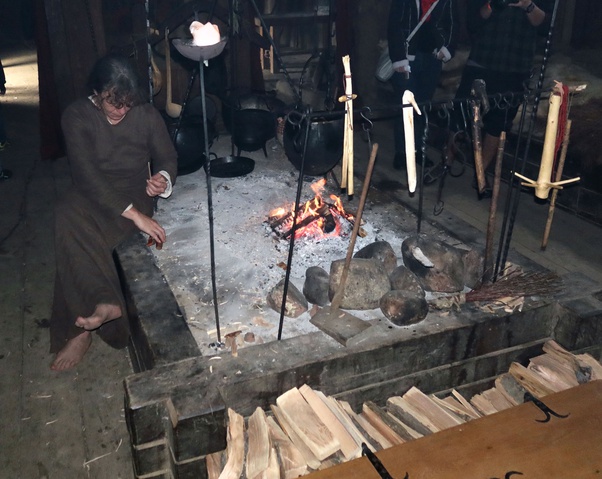
Privacy, as we know it, didn’t exist. Life in a Norse longhouse was a very intimate affair.
If you met a Norse person, the first thing that you would notice is the over-powering smell of wood smoke. I once spent a day in an authentic longhouse and it took me four or five long showers to get rid of the smoke smell from my skin. We took my clothes home in a large bin sack to stop them spreading their perfume to the rest of the clothes in our case.
The wood smoke is in every molecule of the longhouse, 24 hours a day, and penetrates right into your skin.
You would never see a button (or clearly a zip either!) Male and female clothing was held together with either laces or pins. We have an Anglo-Saxon pin and sometimes get it out and wonder at the lady who wore it 800 years or so ago.
正如我们所知,隐私并不存在。在挪威长屋中生活是一件非常亲密的事情。
如果你遇到一个挪威人,你会注意到的第一件事就是浓的化不开的木柴的烟味。我曾经在一个真正的长屋里度过了一天,结束后洗了四五次澡,每次都花了很长时间只为了摆脱我皮肤上的烟味。我们用一个大麻袋把我的衣服带回家,阻止他们把香水撒在我们的箱子里的其他衣服上。
木烟每天24小时弥漫在长屋的每一个分子中,并最终渗透到你的皮肤里去。
(在这里)你永远也看不到按钮(或者明显的拉链!)男女服装用鞋带或别针固定在一起。 我们有一个盎格鲁-撒克逊人的别针,有时把它拿出来观察,并好奇800年前的女人是怎么把它穿起来的。
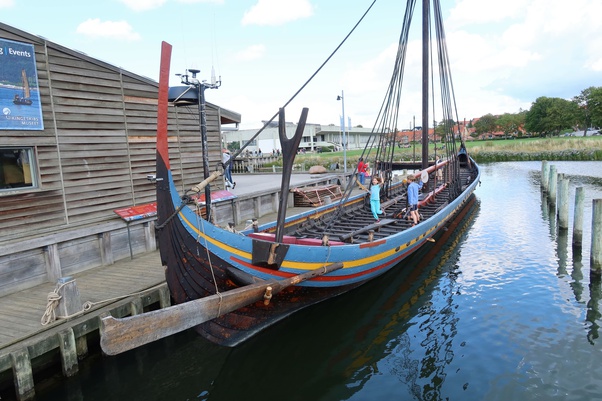
A fully manned warship, with 60 or so skilled seaman/soldiers, could comfortably cover 300 miles in day. Compare this with a very fast horseman, with a fine mount, who could manage - at best - 30 miles a day.
Better still, a Norse warship could manoeuvre extremely well in all wind conditions. It could change tack - go from one direction to another - in less than ten minutes. This information came from one of the skippers of the Sea Stallion, pictured above.
一艘全副武装的战舰拥有大约60名熟练的海员/士兵,每天可以轻松航行300英里。与之相比一个速度很快的骑手加上一个很好的坐骑每天也最多只能跑30英里。
更妙的是一艘挪威军舰在所有的风向条件下都可以非常容易地操纵。它可以在不到十分钟的时间内改变方向。这些信息来自上图所示的海狮船长。
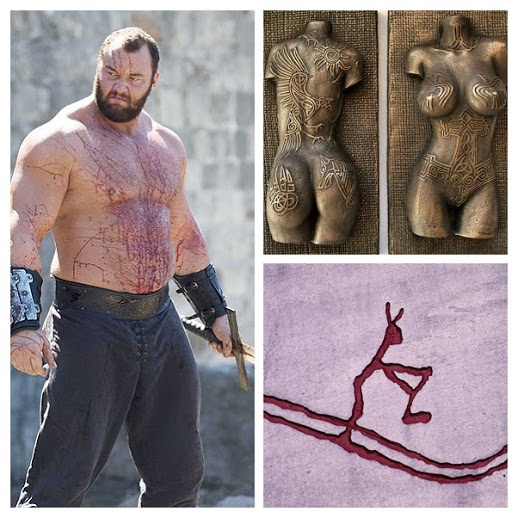
WOMEN HAD LEFTS, AND RIGHTS
We might often imagine the poor women in the Viking era as being practically enslaved as some kind of lust —and work obxts, but we could not be more wrong.
In fact, Viking civilization was much more complex and progressive than most of us think — popular T. V. series do not help to nuance this distorted image — and the role of women adds an extra layer.
You see, in Viking age Scandinavia women could own property and even request a divorce !
If the marriage ended, they could reclaim their “dowries,” and sure: most marriages were arranged and negotiated by the families involved, but in stark contrast even to some of our modern day societies in which arranged marriages still are the norm, the bride had a say in the arrangement.
妇女拥有的权利
我们常常把维京时代的可怜妇女想象成被奴役为某种泄欲工具或工作对象,但其实我们错的离谱。
事实上,维京文明比我们大多数人想象的要复杂进步得多——流行的影视剧并不能帮助区分这种扭曲的形象——而且女性的角色甚至额外增加了一层。
你看,维京时代斯堪的纳维亚女人可以拥有财产,甚至能主动要求离婚!
如果婚姻结束,他们可以收回他们的“嫁妆”,而且是肯定的:大多数婚姻都是由有关家庭安排和谈判,但与我们现代社会中仍以包办婚姻为常态的一些社会形成鲜明对比的是新娘在安排上有自己的发言权。
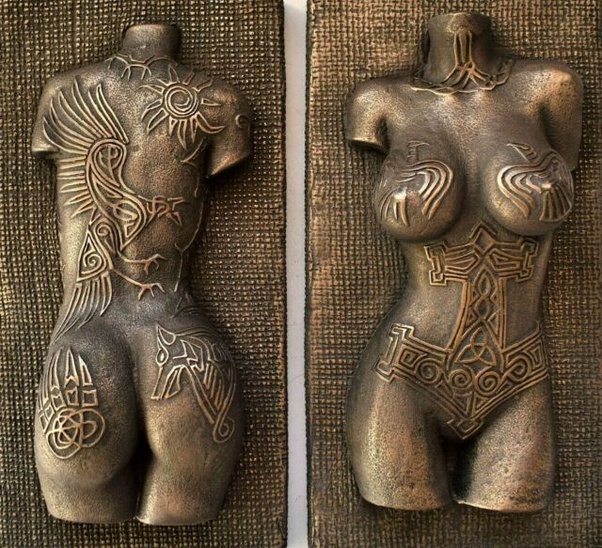
VIKINGS WERE FARMERS
Yes, even the wildest beast of Viking was a simple farmer at home base.
Living together with a number of other families in the famous and enormous central longhouses that originally contained besides themselves also tools, live animals, food storage and workshops, the central social place in the longhouse was a large fire pit.
It most probably burned all the time, given the cruel Nordic climate.
And for that reason, there weren’t any windows nor large gaps in the walls and roofs of longhouses, so that they would have been dark, and misty.
Just imagine the mystic stories about hammered gods and giant wolves that would have been told around the evening fire, all members close together, with the freezing bite of Winter in their backs …
维京人是农民
是的,即使是维京最凶猛的野兽也是家里一个简单的农民。
与许多其他家庭一起生活在著名和巨大的中央长屋里,这些长屋的功能最初包含工具、活的动物、食物储存屋和工作车间,长屋的中是一个大火坑。
由于北欧气候恶劣,它很可能一直在燃烧。
由于这个原因,长屋的墙壁和屋顶上没有窗户,也没有很大的缝隙,所以它们通常是黑暗的,像笼罩着薄雾。
想象一下,那些关于锤击的神和巨大的狼的神秘故事,它们会在夜晚篝火周围被讲述,所有的成员都在一起,在他们的背上被冬天冻死了。。。
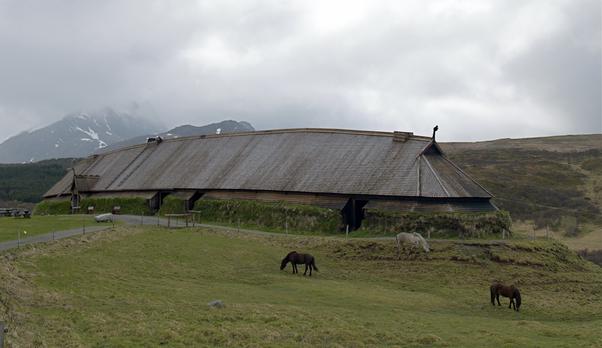
VIKINGS COULD DRAW MORE THAN THEIR SWORDS
There are some truly phenomenal sites in Scandinavia that harbor rock carvings of ancient symbols and scenes from historical Viking life.
My personal favorites are the petroglyphs found in Tanumshede (Bohuslän, Sweden), an amazing UNESCO World Heritage site containing thousands of images from the Bronze and Iron age.[2]
One can see boats, whales, Thor-like male figures with large hammers, but also chariots, birds and males with large erections.
维京人画画比他们用剑还多
在斯堪的纳维亚有一些真正非凡的遗址,那里藏有古代符号和历史上维京人生活场景的石刻。
我个人最喜欢的是在Tanumshede(瑞典Bohuslan)发现的岩画,这是一个令人惊叹的联合国教科文组织世界遗产,包含了数千幅来自青铜和铁器时代的图像。
人们可以看到船,鲸鱼,雷神般的男性人物与大锤,但也有战车,鸟类,与男性硕大的勃起…。
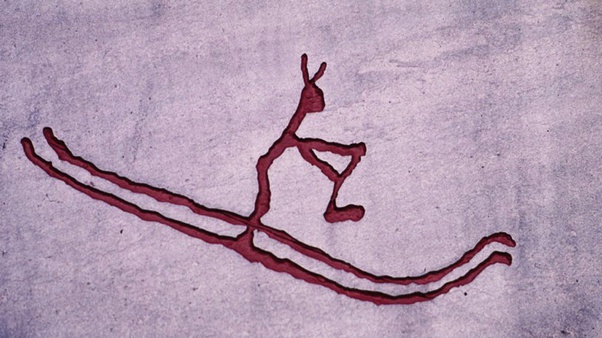
So there you have it: Vikings were wife-loving artistic farm boys on skis.
Spread the word.
所以现在你明白了:维京人是关爱妻子,喜爱滑雪和艺术的农场大男孩。
Frank Melling
As has been noted in other answers, there were no “Vikings” but there was a degree of commanality between the northern European countries and tribal areas - let’s call them the “Norse”.
Here are a few bits and pieces from the whole spectrum of Norse life which might be surprising.
正如其他答案中所指出的,没有所谓的“维京人”这个群体,但北欧国家和部落地区之间有一定程度的共产主义-我们称之为“挪威”。
这里有一些来自挪威生活中的可能会令你惊讶不已的事情。
As has been noted in other answers, there were no “Vikings” but there was a degree of commanality between the northern European countries and tribal areas - let’s call them the “Norse”.
Here are a few bits and pieces from the whole spectrum of Norse life which might be surprising.
正如其他答案中所指出的,没有所谓的“维京人”这个群体,但北欧国家和部落地区之间有一定程度的共产主义-我们称之为“挪威”。
这里有一些来自挪威生活中的可能会令你惊讶不已的事情。
The Norse washed their hands before meals.
They conducted a constant war against hair nits and had very fine combs for removing them.
If you were in a Norse village during daylight you would notice how incredibly busy it was. Men and women, children and animals were all doing something productive. Down time didn’t exist.
Norse women could alter the temperature on their cooking fires very accurately. I actually saw this done by a hard core re-enactor in Denmark who had a range of different heats available to her. She “turned up the heat” by some clever blowing on hot embers with a reed.
挪威人饭前洗手。
他们不断地与发髻进行斗争,并用非常精细的梳子来清理它们。
白天在挪威的一个村庄里时你会注意到那里难以置信的繁忙。男人女人,儿童和动物都在做与生产相关的事情,几乎没有休息时间。挪威妇女可以非常准确地调整她们烹饪时的火焰温度。我实际上看过丹麦一个硬核演员完成的一系列神奇操作。她用一根芦苇巧妙地吹着滚烫的余烬,“打开了热气。”
They conducted a constant war against hair nits and had very fine combs for removing them.
If you were in a Norse village during daylight you would notice how incredibly busy it was. Men and women, children and animals were all doing something productive. Down time didn’t exist.
Norse women could alter the temperature on their cooking fires very accurately. I actually saw this done by a hard core re-enactor in Denmark who had a range of different heats available to her. She “turned up the heat” by some clever blowing on hot embers with a reed.
挪威人饭前洗手。
他们不断地与发髻进行斗争,并用非常精细的梳子来清理它们。
白天在挪威的一个村庄里时你会注意到那里难以置信的繁忙。男人女人,儿童和动物都在做与生产相关的事情,几乎没有休息时间。挪威妇女可以非常准确地调整她们烹饪时的火焰温度。我实际上看过丹麦一个硬核演员完成的一系列神奇操作。她用一根芦苇巧妙地吹着滚烫的余烬,“打开了热气。”
Also, note the range of cooking implements in this image.
此外,请注意此图像中烹饪工具的范畴有多广。
此外,请注意此图像中烹饪工具的范畴有多广。

Privacy, as we know it, didn’t exist. Life in a Norse longhouse was a very intimate affair.
If you met a Norse person, the first thing that you would notice is the over-powering smell of wood smoke. I once spent a day in an authentic longhouse and it took me four or five long showers to get rid of the smoke smell from my skin. We took my clothes home in a large bin sack to stop them spreading their perfume to the rest of the clothes in our case.
The wood smoke is in every molecule of the longhouse, 24 hours a day, and penetrates right into your skin.
You would never see a button (or clearly a zip either!) Male and female clothing was held together with either laces or pins. We have an Anglo-Saxon pin and sometimes get it out and wonder at the lady who wore it 800 years or so ago.
正如我们所知,隐私并不存在。在挪威长屋中生活是一件非常亲密的事情。
如果你遇到一个挪威人,你会注意到的第一件事就是浓的化不开的木柴的烟味。我曾经在一个真正的长屋里度过了一天,结束后洗了四五次澡,每次都花了很长时间只为了摆脱我皮肤上的烟味。我们用一个大麻袋把我的衣服带回家,阻止他们把香水撒在我们的箱子里的其他衣服上。
木烟每天24小时弥漫在长屋的每一个分子中,并最终渗透到你的皮肤里去。
(在这里)你永远也看不到按钮(或者明显的拉链!)男女服装用鞋带或别针固定在一起。 我们有一个盎格鲁-撒克逊人的别针,有时把它拿出来观察,并好奇800年前的女人是怎么把它穿起来的。
Norse clothing was often beautiful and came in a wide range of qualities. My wife tells me that she would be happy to wear a fine, embroidered, linen blouse today.
Norse shoes and boots weren’t left or right footed.
The best smiths were wonderfully skillful. A well made blade would have 24 rods of iron and steel hammer welded together.
Norse sailors were incredibly good seamen and Norse longships were the fastest form of transport in the world - and by a long margin too.
北欧服装往往很漂亮具有广泛的品质。我妻子告诉我,她今天会很乐意穿一件精致的绣花亚麻衬衫。
北欧鞋和靴子没有左脚或右脚之分。
最优秀的铁匠技艺高超。一个做工良好的刀片是有24棒钢铁锤焊在一起的。
挪威的水手们是非常优秀的海员,挪威的长船是世界上最快的运输方式-而且也能航行很远。
Norse shoes and boots weren’t left or right footed.
The best smiths were wonderfully skillful. A well made blade would have 24 rods of iron and steel hammer welded together.
Norse sailors were incredibly good seamen and Norse longships were the fastest form of transport in the world - and by a long margin too.
北欧服装往往很漂亮具有广泛的品质。我妻子告诉我,她今天会很乐意穿一件精致的绣花亚麻衬衫。
北欧鞋和靴子没有左脚或右脚之分。
最优秀的铁匠技艺高超。一个做工良好的刀片是有24棒钢铁锤焊在一起的。
挪威的水手们是非常优秀的海员,挪威的长船是世界上最快的运输方式-而且也能航行很远。

A fully manned warship, with 60 or so skilled seaman/soldiers, could comfortably cover 300 miles in day. Compare this with a very fast horseman, with a fine mount, who could manage - at best - 30 miles a day.
Better still, a Norse warship could manoeuvre extremely well in all wind conditions. It could change tack - go from one direction to another - in less than ten minutes. This information came from one of the skippers of the Sea Stallion, pictured above.
一艘全副武装的战舰拥有大约60名熟练的海员/士兵,每天可以轻松航行300英里。与之相比一个速度很快的骑手加上一个很好的坐骑每天也最多只能跑30英里。
更妙的是一艘挪威军舰在所有的风向条件下都可以非常容易地操纵。它可以在不到十分钟的时间内改变方向。这些信息来自上图所示的海狮船长。
Finally, a Norse longship was blisteringly quick when powered by oar.
This meant that Norse raiders could hit hard at multiple targets great distances apart.
Norse navigation was also unparalled. Norse skippers had little magnetic fish hung from fine linen threads to give them magnetic north bearings; calcite crystals (referred to as “sunstone” in Norse sagas) to give headings in very cloudy weather and a vast knowledge of celestial navigation.
Together, this technology allowed the Norse longships to be sailed hard in even the most brutal conditions.
In short, these people had a lot more about them than simply being drunk and killing people.
最后,一艘挪威长船在桨驱动下速度快得惊人。
这意味着北欧的这群突袭者可能会对相距很远的多个目标猛烈攻击。
挪威语导航也是无懈可击。挪威船长的细亚麻线挂着一个小小的磁性鱼坠,可以使它们变成磁性指北器。方解石晶体(在北欧萨加斯语中称为“太阳石”)在非常多云的天气和丰富的天体导航知识中会成为瞩目焦点。
以上这些技术加在一起使得挪威的的长船即使在最残酷的条件下也能艰难航行。
简而言之,对他们的了解不能仅仅只是醉酒和杀人。
This meant that Norse raiders could hit hard at multiple targets great distances apart.
Norse navigation was also unparalled. Norse skippers had little magnetic fish hung from fine linen threads to give them magnetic north bearings; calcite crystals (referred to as “sunstone” in Norse sagas) to give headings in very cloudy weather and a vast knowledge of celestial navigation.
Together, this technology allowed the Norse longships to be sailed hard in even the most brutal conditions.
In short, these people had a lot more about them than simply being drunk and killing people.
最后,一艘挪威长船在桨驱动下速度快得惊人。
这意味着北欧的这群突袭者可能会对相距很远的多个目标猛烈攻击。
挪威语导航也是无懈可击。挪威船长的细亚麻线挂着一个小小的磁性鱼坠,可以使它们变成磁性指北器。方解石晶体(在北欧萨加斯语中称为“太阳石”)在非常多云的天气和丰富的天体导航知识中会成为瞩目焦点。
以上这些技术加在一起使得挪威的的长船即使在最残酷的条件下也能艰难航行。
简而言之,对他们的了解不能仅仅只是醉酒和杀人。
Mats Andersson
Descendant of vikings, including Sigurd who slew Fafnir
维京人的后裔,杀掉过侏儒
Descendant of vikings, including Sigurd who slew Fafnir
维京人的后裔,杀掉过侏儒
Answered September 3
Thanks for the A2A.
Something I rarely see mentioned in English language texts is the human sacrifice. It wasn’t exactly a huge drain on the population—the written records that remain seem to indicate that at major sites of worship, nine people were sacrificed every nine years—but it was definitely a fairly wide-spread practice.
Another thing which is well-known in Scandinavia, but which recently seems to have taken some English-speakers by surprise, is that the Viking trade was built on slavery. Not anything resembling the American chattel slavery of the 18th and 19th centuries, but more akin to the Roman practice, where a slave was very valuable property, akin to a high-end car to us. As pagans, the Vikings could go to Muslim countries and raid for slaves along the European coast on the way. Christians were banned by the Vatican from selling other Christians as slaves, but the Vikings were of course not bothered by that. They also brought slaves home, but it’s been estimated that the slaves never outnumbered the freeborn, and after slavery was abolished in 1135 they simply integrated completely into society.
谢谢你的邀请。
我在英语文本中很少看到提到的东西是人类的牺牲。 这并不是人口的巨大流失,留下的书面记录似乎表明,在主要的礼拜场所,每9年有9人被处死,但这绝对是一个相当广泛的做法。
斯堪的纳维亚半岛的另一件众所周知,但最近似乎让一些说英语的人感到惊讶的事是维京人的贸易是建立在奴隶制基础上的。不是任何类似于18和19世纪美国奴隶制的东西,而是更类似于罗马的旧惯例,那里的奴隶是非常宝贵的财产,类似于我们的高端汽车。作为异教徒的维京人可以前往穆斯林国家,并在途中的欧洲海岸搜捕奴隶。梵蒂冈禁止基督徒把其他基督徒当作奴隶出售,但维京人不会有此烦恼。他们还把奴隶带回家。但据估计挪威的奴隶数量从未超过自由出生的人,在1135年奴隶制被废除后,他们已经完全融入了当地的社会。
原创翻译:龙腾网 https://www.ltaaa.cn 转载请注明出处
Thanks for the A2A.
Something I rarely see mentioned in English language texts is the human sacrifice. It wasn’t exactly a huge drain on the population—the written records that remain seem to indicate that at major sites of worship, nine people were sacrificed every nine years—but it was definitely a fairly wide-spread practice.
Another thing which is well-known in Scandinavia, but which recently seems to have taken some English-speakers by surprise, is that the Viking trade was built on slavery. Not anything resembling the American chattel slavery of the 18th and 19th centuries, but more akin to the Roman practice, where a slave was very valuable property, akin to a high-end car to us. As pagans, the Vikings could go to Muslim countries and raid for slaves along the European coast on the way. Christians were banned by the Vatican from selling other Christians as slaves, but the Vikings were of course not bothered by that. They also brought slaves home, but it’s been estimated that the slaves never outnumbered the freeborn, and after slavery was abolished in 1135 they simply integrated completely into society.
谢谢你的邀请。
我在英语文本中很少看到提到的东西是人类的牺牲。 这并不是人口的巨大流失,留下的书面记录似乎表明,在主要的礼拜场所,每9年有9人被处死,但这绝对是一个相当广泛的做法。
斯堪的纳维亚半岛的另一件众所周知,但最近似乎让一些说英语的人感到惊讶的事是维京人的贸易是建立在奴隶制基础上的。不是任何类似于18和19世纪美国奴隶制的东西,而是更类似于罗马的旧惯例,那里的奴隶是非常宝贵的财产,类似于我们的高端汽车。作为异教徒的维京人可以前往穆斯林国家,并在途中的欧洲海岸搜捕奴隶。梵蒂冈禁止基督徒把其他基督徒当作奴隶出售,但维京人不会有此烦恼。他们还把奴隶带回家。但据估计挪威的奴隶数量从未超过自由出生的人,在1135年奴隶制被废除后,他们已经完全融入了当地的社会。
原创翻译:龙腾网 https://www.ltaaa.cn 转载请注明出处
As for the freeborn, the Vikings practised a form of proto-democracy. Kings and chieftains were elected (usually for life, which of course was rarely for incredibly long anyway back then), and legal disputes were settled at the Ting, a regular gathering of all free men in an area.
Viking women enjoyed a much higher status in society than they had later, under Christianity. They had a well-defined legal status, and were considered to be if not the head of the household, so at least the stewards; the wife held all the keys to the various locks. They also went on Viking raids and took part in battle; shield-maidens (“sköldmö” in Swedish) were common enough so that there was a word for them.
至于自由出生的人,维京人实行一种原始民主的形式。国王和酋长都是选举产生的(通常是终身的,当然这在当时是很少的难以置信的长时间),法律纠纷在丁那里得到解决,这是一个地区所有自由人的定期聚会。
维京妇女在社会上的地位比她们后来在基督教下的地位高得多。他们有明确的法律地位,即使不是户主也至少是管家;妻子持有家中所有各种锁的钥匙。他们还参加维京人的突袭并参加了战斗;盾牌女仆(瑞典语中的“skoldmo”)很常见,所以可以有一个专门的词来形容他们。
Viking women enjoyed a much higher status in society than they had later, under Christianity. They had a well-defined legal status, and were considered to be if not the head of the household, so at least the stewards; the wife held all the keys to the various locks. They also went on Viking raids and took part in battle; shield-maidens (“sköldmö” in Swedish) were common enough so that there was a word for them.
至于自由出生的人,维京人实行一种原始民主的形式。国王和酋长都是选举产生的(通常是终身的,当然这在当时是很少的难以置信的长时间),法律纠纷在丁那里得到解决,这是一个地区所有自由人的定期聚会。
维京妇女在社会上的地位比她们后来在基督教下的地位高得多。他们有明确的法律地位,即使不是户主也至少是管家;妻子持有家中所有各种锁的钥匙。他们还参加维京人的突袭并参加了战斗;盾牌女仆(瑞典语中的“skoldmo”)很常见,所以可以有一个专门的词来形容他们。
Also, married Viking women were required to cover their hair, much in the way of contemporary Muslims. That practice continued well into the 1960s, and the last huckle I saw was on the bus in Stockholm in the late 1990s.
Something that is rarely mentioned even in Scandinavia is that the Viking men were incredibly vain. They spent lots of time grooming their hair and beards, and while they rarely lugged weaponry around when they ventured outdoors, they would rather have died than leave their combs and earspoons behind. Archaeological finds indicate that they were particularly fond of green mascara, something you rarely see when they’re depicted on TV.
此外,已婚的维京妇女被要求遮住头发,这很大程度上是当代穆斯林的做法。这种做法一直持续到20世纪60年代,我最后一次看到女人遮发是1990年代末在斯德哥尔摩的公共汽车上。
即使在斯堪的纳维亚半岛也很少提及的一点是维京人难以置信的虚荣。他们花了很多时间打理自己的头发和胡须,虽然他们在户外冒险时很少拉下武器,但相比之下他们宁愿死也不愿丢掉梳子和耳塞。考古发现表明他们特别喜欢绿色的睫毛膏,相比于荧屏上的形象这是你在现实生活中很少看到的
Something that is rarely mentioned even in Scandinavia is that the Viking men were incredibly vain. They spent lots of time grooming their hair and beards, and while they rarely lugged weaponry around when they ventured outdoors, they would rather have died than leave their combs and earspoons behind. Archaeological finds indicate that they were particularly fond of green mascara, something you rarely see when they’re depicted on TV.
此外,已婚的维京妇女被要求遮住头发,这很大程度上是当代穆斯林的做法。这种做法一直持续到20世纪60年代,我最后一次看到女人遮发是1990年代末在斯德哥尔摩的公共汽车上。
即使在斯堪的纳维亚半岛也很少提及的一点是维京人难以置信的虚荣。他们花了很多时间打理自己的头发和胡须,虽然他们在户外冒险时很少拉下武器,但相比之下他们宁愿死也不愿丢掉梳子和耳塞。考古发现表明他们特别喜欢绿色的睫毛膏,相比于荧屏上的形象这是你在现实生活中很少看到的
Thomas Cayne
, Storyteller. Anthropologist. Naturalist. Madman.
Answered Thu · Upvoted by
James Curtis
, studied History & Latin American Studies at University of Oregon
Here are some remarkable facts about Vikings.
So let’s sit around the fire, and listen to Old Norse voices …
这里有一些关于维京人的显著事实。
所以让我们围坐在炉火旁,听听古挪威的声音。。。
, Storyteller. Anthropologist. Naturalist. Madman.
Answered Thu · Upvoted by
James Curtis
, studied History & Latin American Studies at University of Oregon
Here are some remarkable facts about Vikings.
So let’s sit around the fire, and listen to Old Norse voices …
这里有一些关于维京人的显著事实。
所以让我们围坐在炉火旁,听听古挪威的声音。。。

WOMEN HAD LEFTS, AND RIGHTS
We might often imagine the poor women in the Viking era as being practically enslaved as some kind of lust —and work obxts, but we could not be more wrong.
In fact, Viking civilization was much more complex and progressive than most of us think — popular T. V. series do not help to nuance this distorted image — and the role of women adds an extra layer.
You see, in Viking age Scandinavia women could own property and even request a divorce !
If the marriage ended, they could reclaim their “dowries,” and sure: most marriages were arranged and negotiated by the families involved, but in stark contrast even to some of our modern day societies in which arranged marriages still are the norm, the bride had a say in the arrangement.
妇女拥有的权利
我们常常把维京时代的可怜妇女想象成被奴役为某种泄欲工具或工作对象,但其实我们错的离谱。
事实上,维京文明比我们大多数人想象的要复杂进步得多——流行的影视剧并不能帮助区分这种扭曲的形象——而且女性的角色甚至额外增加了一层。
你看,维京时代斯堪的纳维亚女人可以拥有财产,甚至能主动要求离婚!
如果婚姻结束,他们可以收回他们的“嫁妆”,而且是肯定的:大多数婚姻都是由有关家庭安排和谈判,但与我们现代社会中仍以包办婚姻为常态的一些社会形成鲜明对比的是新娘在安排上有自己的发言权。
Here is another view on the domestic atmosphere of that time:[1]
Though the man was the “ruler” of the house, the woman played an active role in managing her husband, as well as the household. Norse women had full authority in the domestic sphere, especially when their husbands were absent. If the man of the household died, his wife would adopt his role on a permanent basis, singlehandedly running the family farm or trading business. Many women in Viking Age Scandinavia were buried with rings of keys, which symbolized their roles and power as household managers.
And although the term “Viking” is almost exclusively used for males, the common occurrence of formidable female warriors in Old Norse texts — think for instance of the famed “Valkyrjer” — suggests that we might want to broaden the term.
虽然男人是房子的“统治者”,但女人在管理丈夫和家庭方面发挥了积极的作用。挪威妇女在家庭领域拥有充分的权力,特别是当她们的丈夫不在家或该家庭的男子死亡时,他的妻子将长期担任他原来的角色,独自经营家庭农场或贸易业务。北欧海盗时代的许多妇女在埋葬时都搭陪葬有大量的钥匙圈,这象征着她们作为家庭管理者的角色和权力。
虽然“维京”一词几乎完全用于男性,但在古挪威文献中还常见到一个可怕的女战士-比如著名的“Valkyrjer”-表明我们可能要扩大这个词的涵盖范围。
Though the man was the “ruler” of the house, the woman played an active role in managing her husband, as well as the household. Norse women had full authority in the domestic sphere, especially when their husbands were absent. If the man of the household died, his wife would adopt his role on a permanent basis, singlehandedly running the family farm or trading business. Many women in Viking Age Scandinavia were buried with rings of keys, which symbolized their roles and power as household managers.
And although the term “Viking” is almost exclusively used for males, the common occurrence of formidable female warriors in Old Norse texts — think for instance of the famed “Valkyrjer” — suggests that we might want to broaden the term.
虽然男人是房子的“统治者”,但女人在管理丈夫和家庭方面发挥了积极的作用。挪威妇女在家庭领域拥有充分的权力,特别是当她们的丈夫不在家或该家庭的男子死亡时,他的妻子将长期担任他原来的角色,独自经营家庭农场或贸易业务。北欧海盗时代的许多妇女在埋葬时都搭陪葬有大量的钥匙圈,这象征着她们作为家庭管理者的角色和权力。
虽然“维京”一词几乎完全用于男性,但在古挪威文献中还常见到一个可怕的女战士-比如著名的“Valkyrjer”-表明我们可能要扩大这个词的涵盖范围。

VIKINGS WERE FARMERS
Yes, even the wildest beast of Viking was a simple farmer at home base.
Living together with a number of other families in the famous and enormous central longhouses that originally contained besides themselves also tools, live animals, food storage and workshops, the central social place in the longhouse was a large fire pit.
It most probably burned all the time, given the cruel Nordic climate.
And for that reason, there weren’t any windows nor large gaps in the walls and roofs of longhouses, so that they would have been dark, and misty.
Just imagine the mystic stories about hammered gods and giant wolves that would have been told around the evening fire, all members close together, with the freezing bite of Winter in their backs …
维京人是农民
是的,即使是维京最凶猛的野兽也是家里一个简单的农民。
与许多其他家庭一起生活在著名和巨大的中央长屋里,这些长屋的功能最初包含工具、活的动物、食物储存屋和工作车间,长屋的中是一个大火坑。
由于北欧气候恶劣,它很可能一直在燃烧。
由于这个原因,长屋的墙壁和屋顶上没有窗户,也没有很大的缝隙,所以它们通常是黑暗的,像笼罩着薄雾。
想象一下,那些关于锤击的神和巨大的狼的神秘故事,它们会在夜晚篝火周围被讲述,所有的成员都在一起,在他们的背上被冬天冻死了。。。

VIKINGS COULD DRAW MORE THAN THEIR SWORDS
There are some truly phenomenal sites in Scandinavia that harbor rock carvings of ancient symbols and scenes from historical Viking life.
My personal favorites are the petroglyphs found in Tanumshede (Bohuslän, Sweden), an amazing UNESCO World Heritage site containing thousands of images from the Bronze and Iron age.[2]
One can see boats, whales, Thor-like male figures with large hammers, but also chariots, birds and males with large erections.
维京人画画比他们用剑还多
在斯堪的纳维亚有一些真正非凡的遗址,那里藏有古代符号和历史上维京人生活场景的石刻。
我个人最喜欢的是在Tanumshede(瑞典Bohuslan)发现的岩画,这是一个令人惊叹的联合国教科文组织世界遗产,包含了数千幅来自青铜和铁器时代的图像。
人们可以看到船,鲸鱼,雷神般的男性人物与大锤,但也有战车,鸟类,与男性硕大的勃起…。
In fact, my most recent tattoo is a copy of a carved boat in Tanum:
事实上,我最近的纹身是塔纳姆的一艘雕刻船的副本:
事实上,我最近的纹身是塔纳姆的一艘雕刻船的副本:
[I’m a true Viking.]
我是真正的维京人。 ]
我是真正的维京人。 ]
What is also not well known is that Vikings already skied for fun since about 6000 years; they even had a god named “Ullr” who was often depicted on skis through some of these rock carvings:
不为人所知的是维京人从大约6000年以来就一直以滑雪为乐;他们甚至有一个名叫“Ullr”的神,经常以站在滑雪板上的形象出现在岩雕描绘上:
不为人所知的是维京人从大约6000年以来就一直以滑雪为乐;他们甚至有一个名叫“Ullr”的神,经常以站在滑雪板上的形象出现在岩雕描绘上:

So there you have it: Vikings were wife-loving artistic farm boys on skis.
Spread the word.
所以现在你明白了:维京人是关爱妻子,喜爱滑雪和艺术的农场大男孩。
很赞 1
收藏